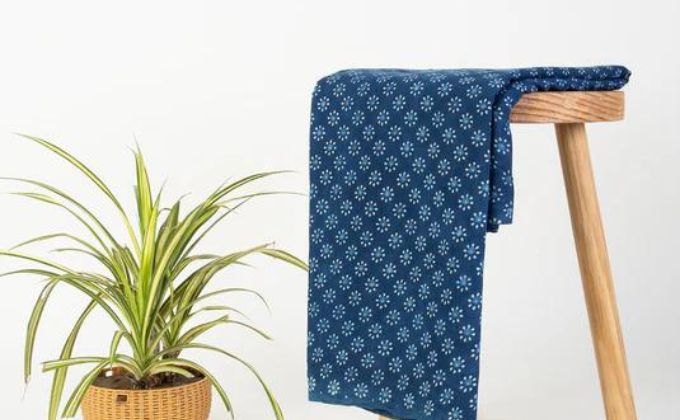Indian indigo fabric holds a special place in the world of textiles, renowned for its rich history, cultural significance, and striking beauty. For generations, indigo dye’s rich, vivid blue color has enthralled people, and it has come to represent natural grace and artistry. From ancient dyeing techniques to contemporary designs, Indian indigo fabric has evolved while retaining its timeless charm.
In this article, we’ll explore the different styles of Indian indigo fabric, its traditional uses, and why it remains a cherished part of both fashion and home décor.
The History of Indigo Fabric in India
India has been using indigo, which is made from the Indigofera tinctoria plant, for thousands of years to make beautiful textiles. Throughout history, indigo has been regarded as “blue gold” because of its scarcity and the difficult extraction and application technique.
Do you want to visit Haridwar? travel agents in Haridwar is the right place to plan your tour. You can book your tour from here.
India’s connection with indigo dates back to the Indus Valley Civilization, where archaeological findings revealed the use of indigo dye for textiles. The dye became a significant part of India’s trade with other civilizations, including the Greeks, Romans, and Egyptians. During the colonial period, indigo was a major export from India, though often through exploitative practices. Today, indigo is celebrated for its artistry and eco-friendly properties, as many artisans use natural dyes in their work.
Styles of Indian Indigo Fabric
Indigo fabric comes in a variety of styles, each showcasing unique designs, patterns, and techniques that reflect India’s diverse cultural heritage. Among the most well-liked looks are:
- Block Prints in Indigo Hand block printing is one of the most recognizable applications of indigo. Artisans hand-carve intricate designs onto wooden blocks, which are then dipped in indigo dye and pressed onto the fabric. This technique creates beautiful geometric patterns, floral designs, and traditional motifs. Indigo block prints are commonly used for apparel, home textiles, and accessories, bringing a touch of tradition to contemporary fashion.
- Shibori (Tie-Dye) Shibori, an ancient tie-dyeing technique, creates mesmerizing patterns on indigo fabric by binding, folding, twisting, or compressing the cloth before dyeing. This technique results in bold, abstract designs that are one-of-a-kind. Shibori indigo fabrics are widely used for scarves, bed linens, and wall hangings, adding an artistic flair to any space.
- Ajrakh Prints Ajrakh is a traditional form of block print fabric that uses indigo alongside other natural dyes. This method comes from the arid areas of Rajasthan and Gujarat. The unique aspect of Ajrakh is its symmetrical, geometric designs, which often feature deep blue indigo contrasted with red, black, and white. Ajrakh prints are used in clothing and home décor, and they showcase the artistry and cultural significance of India’s textile heritage.
- Dabu Indigo Prints Dabu is a mud-resist block printing technique, where artisans apply a paste of mud, lime, and natural gum to the fabric before dyeing it in indigo. The areas covered by the paste resist the dye, resulting in intricate, dual-tone patterns. Dabu prints often feature traditional Indian motifs, such as paisleys, flowers, and vines, making them a favorite for home textiles and clothing.
- Indigo Kalamkari Kalamkari is an art form where artisans use natural dyes, including indigo, to hand-paint or block-print designs onto fabric. Indigo is often used as a base color, with artists adding intricate floral and mythological motifs in vibrant hues. This style of indigo fabric is prized for its storytelling, as the designs often depict scenes from Indian epics like the Ramayana or Mahabharata.
Why Indian Indigo Fabric Remains Timeless
There are several reasons why Indian indigo fabric has remained a timeless part of the global fashion and textile world:
Do you want to visit char dham? char dham tour operator is the right place to plan you Char Dham tour. You can book you tour from here.
- Natural and Eco-Friendly: Indigo is one of the few natural dyes that come from plant sources, making it an eco-friendly alternative to synthetic dyes. As sustainable fashion continues to grow, indigo fabric is becoming increasingly popular for its environmentally conscious production process.
- Cultural Heritage: Wearing or using indigo fabrics is a way to connect with India’s rich cultural heritage. The centuries-old techniques used to create indigo fabric, such as hand block printing and tie-dye, have been passed down through generations of artisans. Every item conveys a tale of artistry and custom.
- Versatility: Indigo fabric is incredibly versatile. Whether used for clothing, home décor, or accessories, the deep blue tones and intricate designs of indigo can elevate any style. It pairs beautifully with other colors and fabrics, making it a timeless choice for both casual and formal wear.
- Enduring Aesthetic: The rich, saturated color of indigo remains as appealing today as it was centuries ago. Its deep blue hue is often associated with tranquility, elegance, and sophistication. Indigo fabric works equally well in modern minimalist settings and traditional, ornate spaces.
How to Incorporate Indigo Fabric into Your Life
Indian indigo fabric is a versatile material that can be incorporated into various aspects of your life. Here are a few ways to bring its timeless beauty into your wardrobe and home:
- Clothing: Indigo fabric is perfect for creating flowing dresses, kurtas, and sarees. Its soft texture and vibrant color make it a go-to choice for both everyday wear and special occasions. Pair an indigo kurta with silver jewelry for an effortless, elegant look.
- Home Décor: Add an indigo touch to your living space with hand-block-printed indigo cushion covers, bedspreads, or curtains. An indigo tie-dye wall hanging or table runner can also bring a pop of color and culture to your home.
- Accessories: Scarves, bags, and even shoes made from indigo fabric offer a chic, modern take on a traditional art form. These items make for perfect gifts or statement pieces in your wardrobe.
Conclusion
The styles and timeless beauty of Indian indigo fabric continue to captivate fashion enthusiasts and design lovers around the world. Whether it’s the meticulous art of block printing, the abstract elegance of Shibori, or the cultural depth of Ajrakh and Kalamkari, indigo fabric represents the intersection of tradition, sustainability, and aesthetic appeal. Embracing indigo fabric in your wardrobe or home décor allows you to celebrate India’s textile heritage while adding a touch of natural elegance to your life.
The story of India’s indigo fabric is one of resilience, artistry, and cultural pride. Thanks to labels like Dmaasa, the ancient craft of indigo dyeing is not only being preserved but also reimagined for the future. By supporting local artisans, embracing sustainable practices, and honoring traditional techniques, Dmaasa is playing a crucial role in keeping the legacy of indigo fabric alive. As consumers continue to value authenticity and craftsmanship, the timeless appeal of indigo will remain as vibrant as ever.





